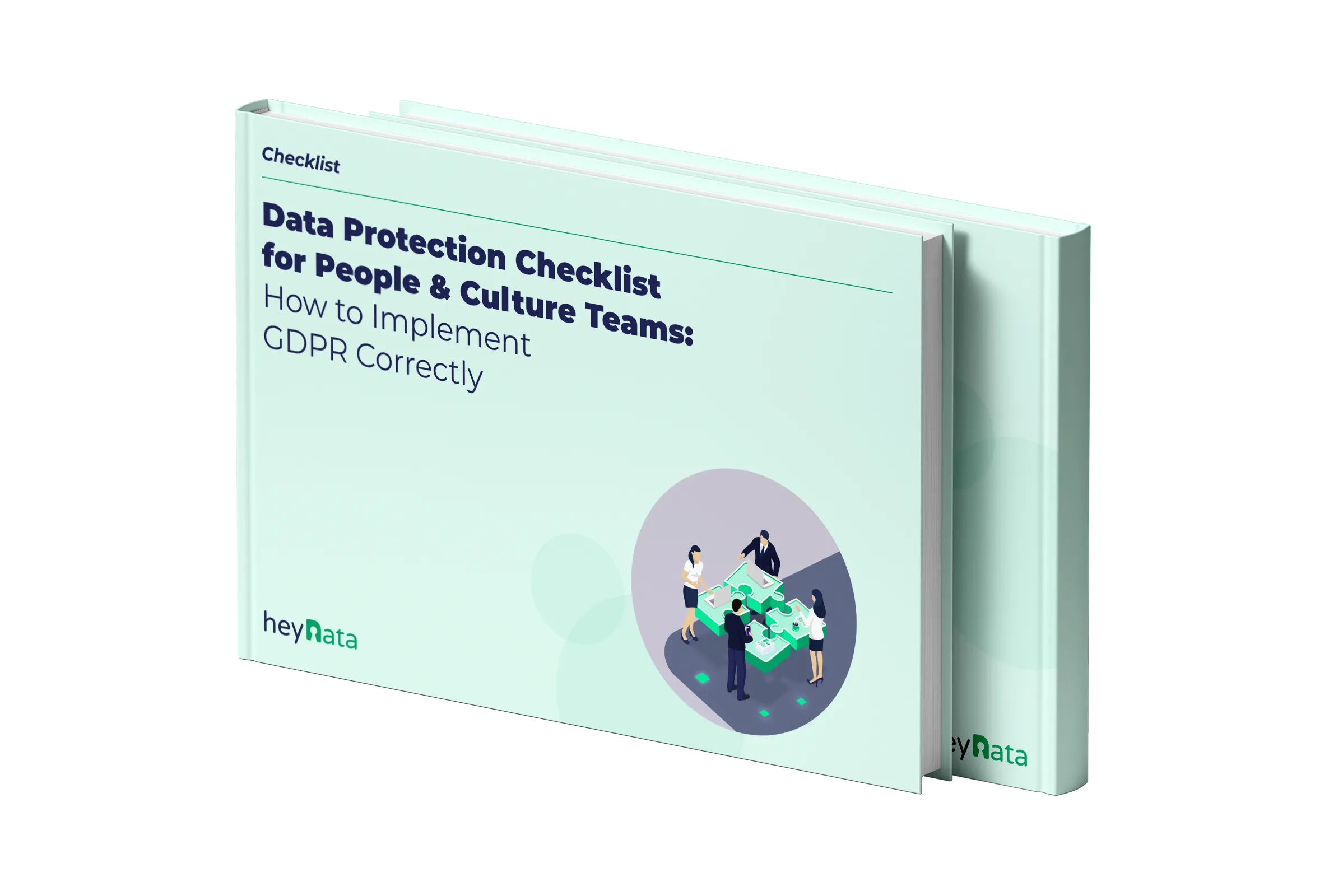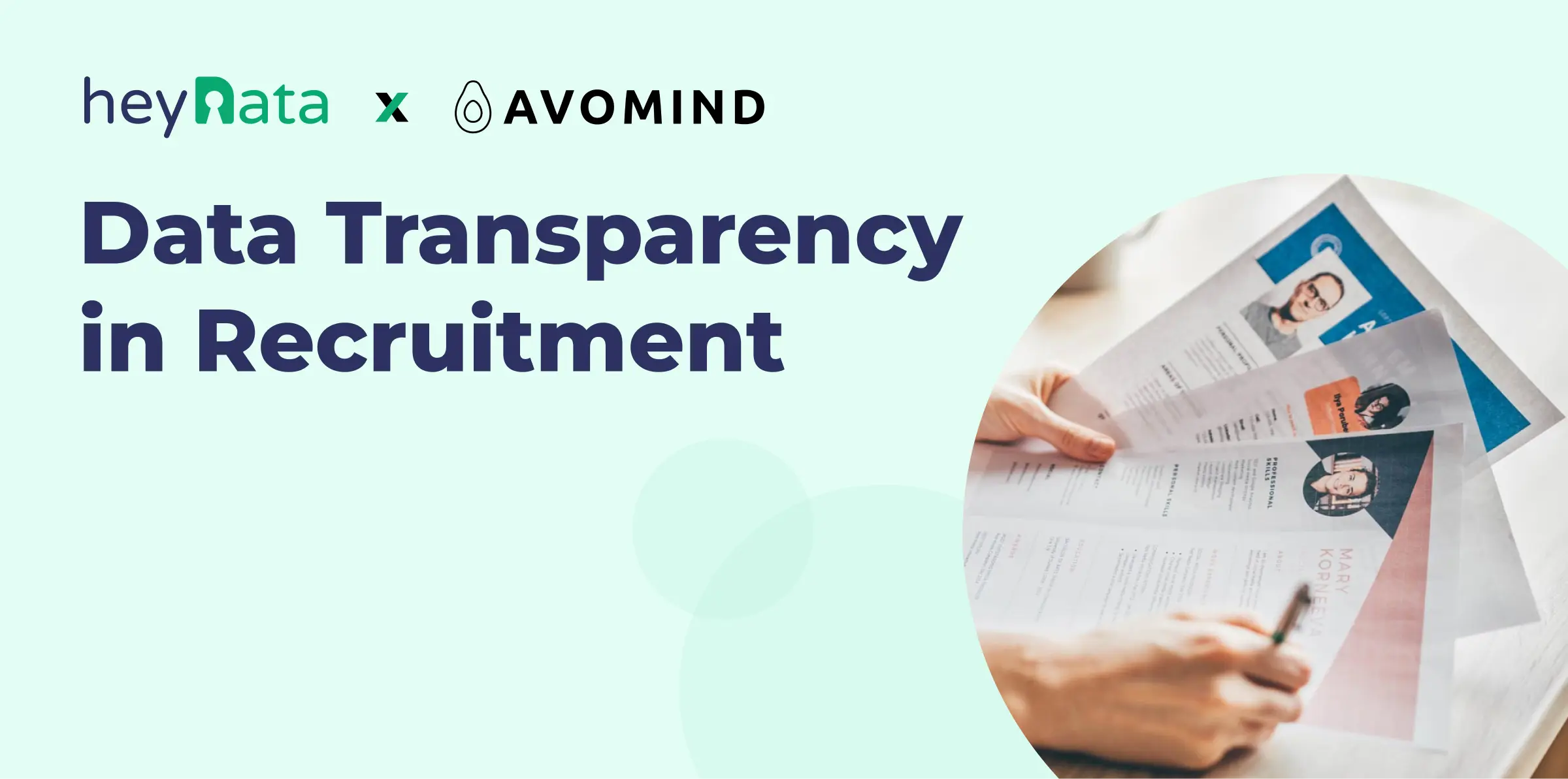
Transparency starts with solid data practices
Get the GDPR checklist for HR teams now.

Why Data Transparency Builds Candidate Trust in Recruitment

'%3e%3cpath%20d='M26.6667%2020.022L30%2023.3553V26.6886H21.6667V36.6886L20%2038.3553L18.3333%2036.6886V26.6886H10V23.3553L13.3333%2020.022V8.35531H11.6667V5.02197H28.3333V8.35531H26.6667V20.022Z'%20fill='%230AA971'/%3e%3c/g%3e%3c/svg%3e) Summary
Summary
- Transparency is a Key Differentiator: 68% of candidates worry about data use; clear communication about data handling builds trust and enhances employer brand.
- Goes Beyond Legal Compliance: Proactive transparency at every hiring stage—from job posting to onboarding—improves candidate experience and retention.
- AI & Fairness: As AI becomes more common in recruitment, companies must explain its use and address fairness, bias, and regulatory compliance.
“If You Wouldn’t Say It to a Candidate’s Face, Don’t Do It to Their Data”
The Importance of Data Transparency in Recruitment in 2025
Trust is hard to win and easy to lose — especially when it comes to personal data. In an age where digital footprints are under constant scrutiny, candidates are more privacy-aware than ever. According to a recent study, 68% of job seekers are concerned about how their personal data is used during the recruitment process. That’s a big number — and a big opportunity.
For recruiters and companies alike, data transparency isn’t just a legal requirement. It’s a trust-building superpower. The organizations that get this right won’t just stay compliant — they’ll win the hearts (and acceptances) of top talent.
Table of Contents:
Transparency Isn’t Just Compliance - It’s How You Win Trust
In the age of hyper-personalized marketing, automated screening, and privacy scandals, candidates are more conscious than ever of how companies treat their data. And they notice the difference between box-ticking and real respect.
Yes, regulations like GDPR and CCPA have raised the floor. But transparency is no longer just a legal obligation — it’s a business advantage.
It shapes candidate experience. It defines your employer brand. And, more often than not, it’s the deciding factor between someone applying — or walking away.
Let’s break it down. Imagine two companies:
- Company A asks for a candidate’s data, but never explains why. After submitting an application, the candidate hears nothing for weeks. There’s no clarity on what happens next — or what happens to their CV. The experience feels cold and transactional.
- Company B includes a short, friendly message at the application stage: "We’re excited to review your profile. Here’s how we’ll handle your data: our hiring system will sort applications, a recruiter will review each profile personally, and we’ll store your data for six months unless you tell us otherwise. You can ask us to delete it at any time — just let us know."
Same process. Totally different perception.
The result? Even if the candidate doesn’t get the job, they walk away feeling seen. Trusted. Respected. That’s the kind of experience that builds brand advocacy and keeps talent in your orbit.
This goes far beyond legal minimums. It’s about being proactive, human, and intentional at every touchpoint. When candidates feel informed and in control.
- They engage more willingly in the process
- They’re more likely to accept offers
- They recommend your company — even if they’re rejected
- They stay open to future roles
Transparency builds emotional equity. It tells candidates, “We care how we make you feel, even if we don’t hire you.”
And in competitive hiring markets, that might just be your edge.
Building Transparency into Every Stage of the Hiring Process
Transparency must be embedded into each phase of recruitment to be truly effective. Let’s look at how it plays out practically:
Job Posting Stage
Be clear about what personal information is necessary at this early point. Avoid requesting unnecessary sensitive data upfront. Being selective not only protects candidates but also signals that your organization values privacy.
Application and Interview Stage
Explain how applicant tracking systems (ATS) work and whether external vendors are involved; even a bit of clarity here can go a long way in easing candidate anxiety and building trust. If automated assessments are used, disclose this upfront and offer alternative paths where feasible.
Offer and Onboarding Stage
Be transparent about background checks, data-sharing with third parties, and any ongoing monitoring post-hire. Candidates are much more comfortable sharing information when they feel ownership over the process.

Transparency starts with solid data practices
Get the GDPR checklist for HR teams now.
What Transparent Hiring Looks Like in Practice
Let’s bring transparency to life through a relatable, real-world-style scenario.
Meet Lena, a digital marketing specialist from Hamburg who’s exploring her next career move after three years in a fast-paced e-commerce company. She’s thoughtful, detail-oriented, and — like many professionals in Germany — takes data privacy seriously.
Here’s what Lena’s experience looks like with a company that prioritizes transparency:
Job Discovery
Lena comes across a role at a Berlin-based tech firm. Alongside the job description, there’s a short, friendly note: “We only collect the personal information necessary to evaluate your application. Here’s how we protect your data and what to expect next.”
No unnecessary forms. No birthdate request. Just clear communication, right from the start.
Application Process
Before submitting her application, Lena is informed that an Applicant Tracking System (ATS) will help screen candidates. The company is upfront about how the tool works — and reassures her that human recruiters make all final decisions. The tone is respectful and clear, not legalistic.
Interview Rounds
During her first video interview, the recruiter explains how Lena’s application data is stored, who has access to it, and how long it will be kept on file. She’s also given the choice to join a talent pool for future openings. Lena feels empowered — she opts in because it’s her decision, not a hidden default.
Post-Interview
Lena isn’t selected this time, but she receives a warm follow-up email within days — with a clear overview of her data rights and a direct link to update or remove her profile. No vague "we’ll keep your resume on file" promises. Just control, clarity, and closure.
Meanwhile, another company Lena applied to still hasn’t responded. She’s unsure whether her CV is sitting in a database, being used for something else, or already forgotten.
Which experience do you think she tells her friends about?
Transparent hiring isn’t about having the flashiest software — it’s about thoughtful, respectful communication at every step. That’s what turns candidates into advocates, and processes into reputations.
Transparency and Technology: A Delicate Balance
The rapid adoption of AI and automation in hiring creates both new opportunities and new risks for transparency. Tools that scan resumes, analyze video interviews, or predict candidate success must be deployed responsibly.
Candidates need to know:
- When AI is being used
- What role it plays in decision-making
- How fairness and bias are being addressed
This is not just good practices, it is increasingly becoming a regulatory expectation. For example, under upcoming EU regulations like the AI Act, organizations will be required to provide clear information when automated decision-making affects individuals.
At heyData, we work closely with clients to help them integrate transparency best practices directly into their recruitment workflows, ensuring that technological innovation and candidate trust grow hand in hand.
Transparency Metrics You Can Track
Transparency, like any other part of your recruitment strategy, should be measurable. Tracking key indicators helps organizations continuously improve the candidate experience and maintain trust over time. Some useful metrics include:
- Consent Rate: The percentage of candidates who give informed consent for data processing without hesitation.
- Data Access Requests: Monitoring how many candidates request access to their personal data can indicate the clarity of your processes.
- Time to Respond to Data Inquiries: How quickly your team responds to candidate questions about data usage.
- Privacy Policy Engagement: Track how often candidates click on or review your privacy policy — high engagement often signals trust and understanding.
- Negative Feedback Related to Privacy: Collect and monitor any concerns or complaints candidates raise about how their data is handled.
- Retention Rates of Candidates in Talent Pools: High opt-in rates for future opportunities often reflect strong trust in your data practices.
By measuring these elements, companies can move beyond assumptions and ensure their transparency initiatives are making a real impact.
A Recruitment Partner’s Responsibility: Setting Standards
The recruitment industry as a whole has a responsibility to champion transparency, not just individual employers. Recruitment firms, which often act as intermediaries handling candidate data on behalf of clients, play a crucial role.
Partners like Avomind integrate transparency as a foundational part of their service models, ensuring that candidates are informed, respected, and protected at every stage of the recruitment journey. When recruitment partners set high standards, it not only protects their clients but also elevates industry expectations overall.
A Final Thought
Here’s a straightforward rule: If you wouldn’t say it to a candidate’s face, don’t do it with their data.
Transparency isn’t about being perfect — it’s about being clear, consistent, and caring every step of the way.
Ready to move from compliance to trust? Start with this:
- Ask yourself: How clear is my communication around candidate data?
Whether it’s privacy notices, consent requests, or explaining AI’s role, clarity builds confidence.
At heyData, we help organizations transform transparency from a legal obligation into a powerful recruitment advantage — delivering respectful, trust-building candidate experiences that set you apart.
Let’s make data transparency your competitive edge.
Frequently asked questions (FAQs)
Why is data transparency important for candidates?
It builds trust, reassures candidates about their data safety, and makes them more likely to engage with your company.
How can companies be more transparent in recruitment?
By clearly explaining what data is collected, how it’s used, and offering candidates choices at every stage.
What role does AI play in recruitment transparency?
Companies must disclose when AI is used in hiring and ensure its use is fair and compliant with regulations.
Important: The content of this article is for informational purposes only and does not constitute legal advice. The information provided here is no substitute for personalized legal advice from a data protection officer or an attorney. We do not guarantee that the information provided is up to date, complete, or accurate. Any actions taken on the basis of the information contained in this article are at your own risk. We recommend that you always consult a data protection officer or an attorney with any legal questions or problems.


